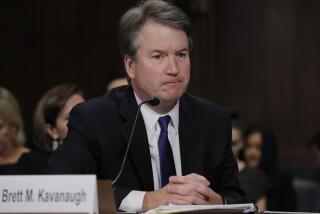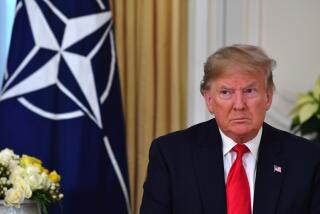Clinton’s Acts ‘Deteriorated Into Illegality’
- Share via
Here are excerpts from Friday’s presentations by GOP House prosecutors in the impeachment trial of President Clinton.
Bill McCollum (Fla.)
The record shows that President Clinton was determined to hide his relationship with Monica Lewinsky from the [Paula Corbin] Jones court. His lawyers will argue to you next week that everything he did to keep the relationship hidden was legal. They will say he may have split a few hairs and evaded answers and given misleading answers, but it was all within the framework of responses and actions that any good lawyer would advise his client to do. They will also say that if he crossed the line technically anywhere he didn’t knowingly or intentionally do so.
Oh, how I wish that were true! We wouldn’t be here today. But, alas, that’s not so.
If you believe the sworn testimony of Monica Lewinsky in this record (and she’s very credible), the president knowingly, intentionally and willfully set out on a course of conduct in December 1997 to lie to the Jones court, to hide his relationship and to encourage others to lie and hide evidence, and to conceal the relationship with Monica Lewinsky from the court.
He engaged in a pattern of obstruction of justice, perjury and witness tampering designed to deny the court what Judge Susan Webber Wright had determined Paula Jones had a right to discover in order to prove her claim.
If you believe the testimony of Monica Lewinsky, you cannot believe the president or accept the arguments of his lawyers. The record is so clear on this that if you have any significant doubt about Monica Lewinsky’s credibility on this testimony, you should have us bring her in here and examine her face-to-face and judge her credibility yourself.
Bob Barr (Ga.)
We have a case here in which the fit between fact and law is as precise as the finely tuned mechanism of a Swiss watch. The evidence that President William Jefferson Clinton committed perjury and obstruction is overwhelming. . . .
A cover story between two teenagers trying to steal a date without their parents knowledge, is one thing. Such would not constitute a crime; it would be something we might wink at. However, we are not here dealing with two love-struck teenagers trying to circumvent their parents’ watchful eyes.
We are dealing with the president of the United States and a subservient employee, concocting and implementing a scheme that, while perhaps not illegal at its inception, deteriorated into illegality once it left the realm of private lie to that of public obstruction. . . .
The perjury is there. The obstruction is there. We ask you to strike down these insidious cancers that eat at our system of government and laws.
Strike it down with the Constitution so it might not fester as a gaping wound, poisoning future generations of children, poisoning our court system and perhaps even poisoning future generations of political leaders.
Just as members of both houses of Congress have been convicted and removed from office for perjury and obstruction, and just as federal judges have been removed by you from life tenure for perjury and obstruction, so must a president; so, sadly, should this president.
George W. Gekas (Pa.)
The clear and convincing evidence establishes that the president of the United States has committed acts which require removal from office. . . . When and how did this course of conduct and the president’s lies first start?
On Dec. 23, 1997, the president committed the first lie under oath and an act of obstruction. He lied on the first occasion he was required by the court to provide discovery concerning . . . evidence that the president provided “sex for jobs.” In other words, sexual harassment evidence that the president treated more favorably in the workplace those women with whom he had sexual relations. In response to the question requiring the president to identify the names of women (other than his wife) with whom he had or sought to have sexual relations while he was the attorney general of the state of Arkansas, governor of the state of Arkansas and president of the United States, he responded, “None.” In truth, as the president well knew, “none” was a false statement under oath because, in addition to Monica Lewinsky, the president . . . also had sexual relations with Gennifer Flowers. . . .
Some argue that the phrase ‘high crimes and misdemeanors’ does not include perjury and obstruction of justice . . . [but] these crimes strike at the very heart of the judicial system. . . . The president employed whatever means he had available . . . to prevent the discovery of the truth before the U.S. District Court and the federal grand jury. He turned the judicial system on its head for his own legal and political gain.
Chris Cannon (Utah)
Some have asserted that an obstruction of justice charge cannot, or should not, be made against the president because some of his acts occurred in the context of a civil trial. There is simply no merit to this view. . . .
The president of the United States endeavored and did obstruct justice and tamper with witnesses in violation of the law of the United States. On numerous occasions he acted with an improper purpose with the intent to interfere with the due administration of justice in the federal civil rights lawsuit filed by Paula Jones. President Clinton corruptly endeavored to persuade witnesses to lie. In some cases, he succeeded. In every case, he violated the law.
President Clinton engaged in misleading conduct in order to influence the testimony of witnesses in judicial proceedings. He succeeded. In each case, he violated the law.
President Clinton acted with an improper purpose to persuade a person to withhold objects from a judicial proceeding in which that person was required to produce them. He succeeded, and in so doing violated the law.
President Clinton made misleading statements for the purpose of deterring a litigant from further discovery that would lead to facts which the judge ordered relevant in a federal civil rights case. In so doing, he obstructed the due administration of justice in that case and violated the law.
Whether attempting to persuade a person to testify falsely, or to ignore court orders to produce objects; whether suggesting to an innocent person a false story in hopes that he or she will repeat it in a judicial proceeding; or testifying falsely in the hopes of blocking another party’s pursuit of the truth--all these acts obstruct justice. All these acts are federal felony crimes. All these acts were committed by William Jefferson Clinton.
Steve Chabot (Ohio)
To this day, the president has refused to acknowledge what the vast majority of Americans know to be true, that he knowingly lied under oath. The president’s continued inability to tell the truth, the whole truth and nothing but the truth has forced this body, this jury to determine the president’s true intent. The intent element requires that the false testimony was knowingly stated and described. This requirement is generally satisfied by proof that the defendant knew his testimony was false at the time it was provided.
As with almost all perjury cases, you will have to make a decision regarding the president’s knowledge of his own false statements, based on the surrounding facts and, yes, by circumstantial evidence. This does not in any way weaken the case against the president. In the absence of an admission by the defendant, relying on circumstantial evidence is virtually the only way to prove the crime of perjury. The federal jury instructions which federal courts use in perjury cases can provide helpful guidance in understanding what is meant by the requirement that the false statement must be made knowingly.
Let me quote from the federal jury instructions. When the word “knowingly” is used, it means that the defendant realized what he was doing and was aware of the nature of his conduct, and did not act through ignorance, mistake or accident. So as you reflect on the president’s carefully calculated statements, remember the federal jury instructions and ask a few simple questions. Did the president realize what he was doing, what he was saying?
Was he aware of the nature of his conduct, or did the president simply act through ignorance, mistake or accident? The answers to these questions are undeniably clear, even to the president’s own attorneys.
More to Read
Get the L.A. Times Politics newsletter
Deeply reported insights into legislation, politics and policy from Sacramento, Washington and beyond. In your inbox twice per week.
You may occasionally receive promotional content from the Los Angeles Times.









